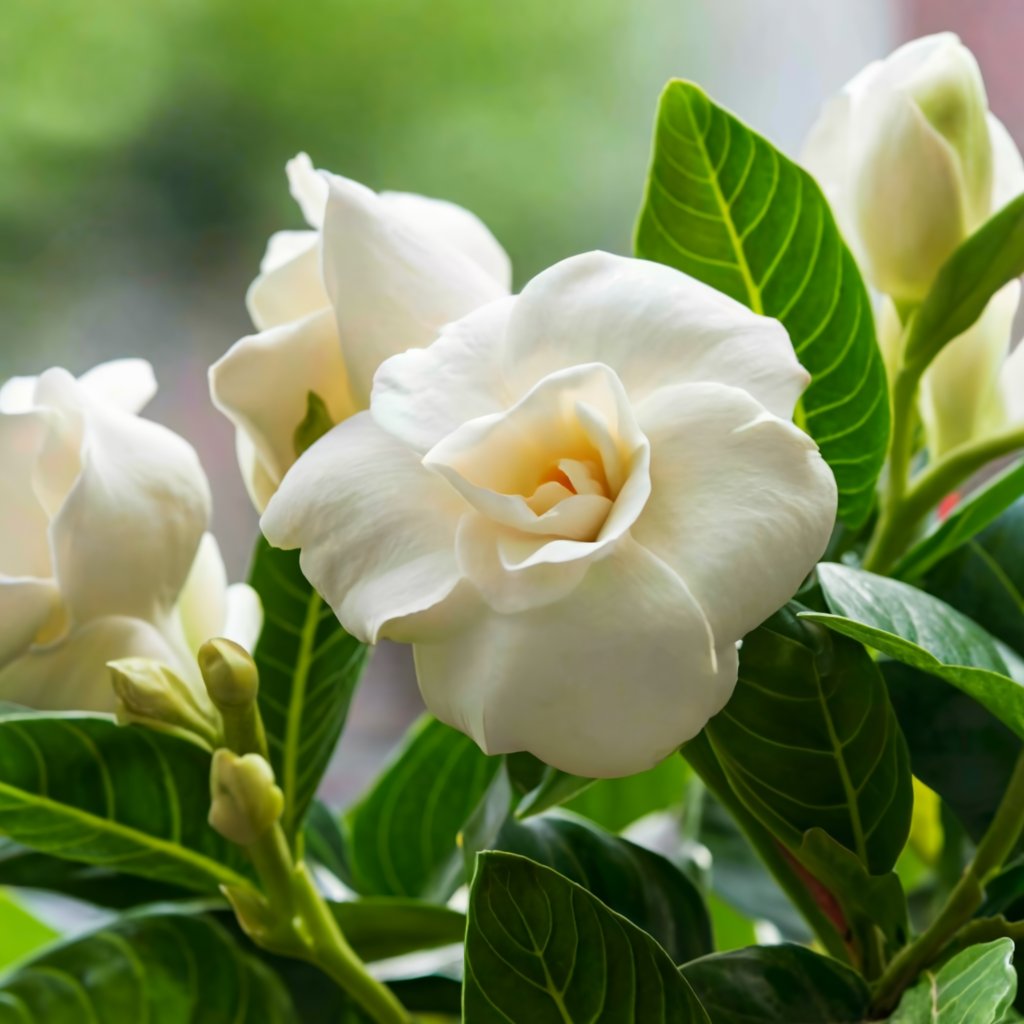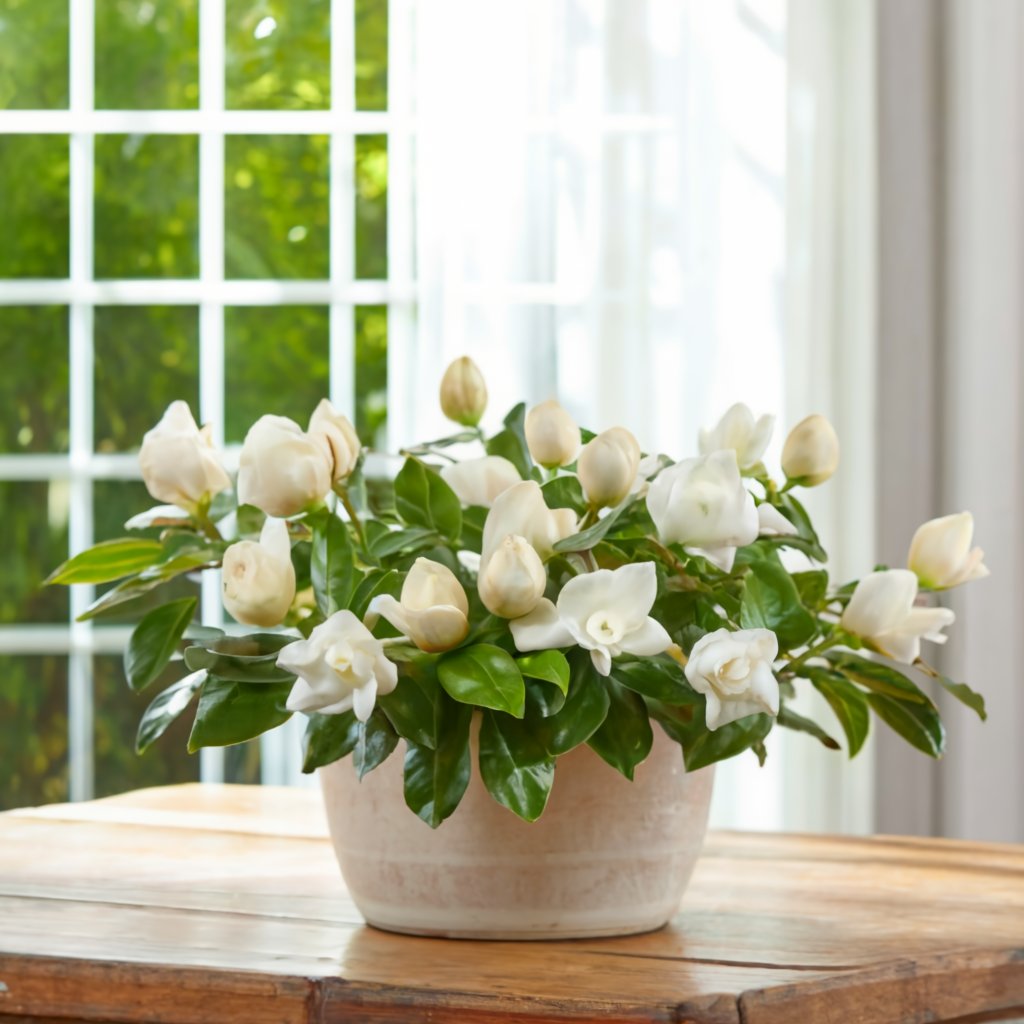
Gardenias, with their intoxicating fragrance and elegant white blooms, are a coveted addition to any garden or home. But their delicate nature can leave some gardeners feeling intimidated. Fear not, fellow plant enthusiast! This guide will unveil the secrets to cultivating and nurturing these captivating flowers, ensuring a season filled with heavenly blooms.
This post may have affiliate links. This means that sometimes when you click a link on our site and make a purchase on Amazon, we may earn a small commission at no additional cost to you. We only recommend products we truly believe in, and your support helps keep us running!
Understanding Your Gardenia

Gardenias (Gardenia jasminoides) are evergreen shrubs native to tropical and subtropical regions of Asia. Their glossy green leaves provide a beautiful backdrop for the large, double blooms that unfurl throughout spring, summer, and even fall.
Types of Gardenias: There are several varieties of gardenias available, each with slightly different needs. The most common type, Gardenia jasminoides ‘August Beauty’, is a reliable bloomer with a compact growth habit. ‘Kleim’s Hardy’ is another popular choice, known for its tolerance to cooler climates.
Know Your Climate: Gardenias thrive in warm, humid environments. If you live in a region with harsh winters, container gardening allows you to bring your gardenia indoors during the colder months.
Setting the Stage for Success

Now that we know our gardenia a little better, let’s prepare the perfect environment for it to flourish.
Choosing the Right Spot:
- Light: Gardenias are sun-worshippers, but with a twist. They crave bright, indirect sunlight. Harsh afternoon sun can scorch the leaves, so consider dappled shade during the hottest part of the day.
- Soil: The key word here is acidic. Aim for a well-draining soil mix with a pH between 5.0 and 6.5. Amending your soil with peat moss or composted pine bark can help achieve the desired acidity.
- Potting Mix (For Container Gardens): Opt for a potting mix specifically formulated for acid-loving plants. These mixes often contain peat moss and perlite to ensure proper drainage and acidity.
Planting and Potting Your Gardenia
Planting Outdoors:
- Timing is Key: The ideal time to plant your gardenia outdoors is in spring or fall, when the temperatures are mild.
- Digging the Hole: Prepare a hole that’s two to three times wider than the root ball of your gardenia.
- Amending the Soil: If your soil isn’t naturally acidic, mix in some amendments like peat moss or sulfur to lower the pH.
- Planting and Mulching: Gently place your gardenia in the hole, ensuring the root ball sits level with the surrounding soil. Backfill the hole, water thoroughly, and apply a layer of mulch around the base of the plant to retain moisture and suppress weeds.
Planting in Containers:
- Choosing the Pot: Select a container with drainage holes that’s at least a few inches larger than the root ball.
- Filling the Pot: Fill the pot with your chosen acidic potting mix.
- Planting: Plant your gardenia at the same depth it was growing in its original container. Water generously.
The Art of Nurturing Your Gardenia
Once your gardenia is settled in its new home, the real magic begins! Here’s how to provide the ongoing care it needs to thrive.
Watering: Consistency is key. Water your gardenia regularly, aiming to keep the soil evenly moist but not soggy. Allow the top inch of soil to dry slightly between waterings.
Feeding: Feed your gardenia with a fertilizer formulated for acid-loving plants during the growing season (spring and summer). Follow the instructions on the fertilizer package for proper application rates and frequency.
Humidity: Gardenias love humidity. If you live in a dry climate, consider misting your plant regularly or using a humidifier to increase the surrounding moisture. Grouping your gardenia with other plants can also help create a more humid microclimate.
Pruning: While not essential, occasional pruning can help maintain your gardenia‘s shape and encourage new growth. Prune after the blooming period has ended, typically in early summer. Remove any dead, diseased, or overgrown branches with sharp pruning shears.
Dealing with Pests and Diseases: Gardenias are susceptible to a few common pests like mealybugs and scale. Regularly inspect your plant and treat infestations promptly with insecticidal soap or neem oil. Fungal diseases can also occur if the soil is consistently soggy. Ensure proper drainage and avoid overwatering.
Witnessing the Reward: Blooms and Beyond
With proper care, your gardenia should reward you with a breathtaking display of fragrant blooms throughout the season. Here are some additional tips to maximize flowering:
Deadheading: Regularly remove spent blooms This encourages the plant to produce more flowers instead of directing its energy towards seed production. Simply pinch off the wilted flower head just above a healthy set of leaves.
- Temperature Control: Gardenias prefer warm temperatures but can struggle in extreme heat. If you live in a hot climate, provide afternoon shade and ensure good air circulation around the plant.
- Patience is a Virtue: Remember, young gardenias may take a year or two to mature and reach their full blooming potential. Don’t be discouraged if you don’t witness a floral explosion right away.
Extending the Season: Winter Care for Container Gardenias
If you live in a region with harsh winters, you can enjoy your gardenia indoors throughout the colder months. Here’s how to provide the necessary winter care:
- Light Matters: Place your gardenia near a sunny window that receives bright, indirect sunlight.
- Temperature Control: Maintain consistent temperatures between 60-75°F (15-24°C) and avoid placing the plant near drafts or heat sources.
- Humidity Matters Even More: Indoor air tends to be drier during winter. Utilize a humidifier or pebble tray with water to increase the humidity around your gardenia.
- Reduce Watering: During winter, your gardenia will enter a period of slower growth. Reduce watering frequency, allowing the soil to dry out slightly more between waterings. Avoid overwatering, which can lead to root rot.
- Limited Fertilization: Hold off on fertilizing your gardenia during the winter months.
Troubleshooting Common Gardenia Ailments
Despite your best efforts, your gardenia might encounter some challenges. Here’s a quick guide to diagnosing and treating some common issues:
- Yellowing Leaves: This could be a sign of several issues, including nutrient deficiency, incorrect watering (overwatering or underwatering), or iron chlorosis (a condition caused by a lack of available iron in the soil). Check your watering habits, ensure proper drainage, and consider using a fertilizer formulated for acid-loving plants. If the issue persists, iron chelates can be applied to address iron chlorosis.
- Brown Spots on Leaves: Fungal diseases like leaf spot can cause brown spots on your gardenia’s leaves. Improve air circulation around the plant, remove any infected leaves, and treat with a fungicide if necessary.
- Bud Drop: Several factors can lead to bud drop, including stress from sudden changes in temperature, inconsistent watering, or lack of light. Ensure consistent care and provide the optimal growing conditions mentioned earlier.
The Joy of Gardenias: A Rewarding Endeavor
Growing gardenias requires dedication and a touch of TLC, but the rewards are truly magnificent. With their intoxicating fragrance and elegant blooms, these captivating plants can transform any space into a fragrant oasis. By following these guidelines and providing the necessary care, you can cultivate healthy, thriving gardenias that will grace your garden or home for years to come. So, embrace the challenge, and witness the magic of these captivating floral wonders unfold in your care!
